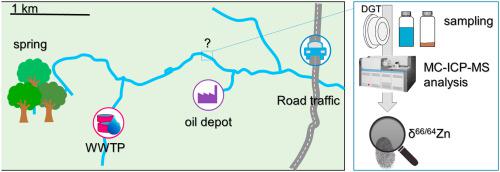当前位置:
X-MOL 学术
›
Appl. Geochem.
›
论文详情
Our official English website, www.x-mol.net, welcomes your
feedback! (Note: you will need to create a separate account there.)
Tracking anthropogenic sources in a small catchment using Zn-isotope signatures
Applied Geochemistry ( IF 3.1 ) Pub Date : 2020-12-01 , DOI: 10.1016/j.apgeochem.2020.104788 Anne-Marie Desaulty , Sébastien Perret , Nicolas Maubec , Philippe Négrel
Applied Geochemistry ( IF 3.1 ) Pub Date : 2020-12-01 , DOI: 10.1016/j.apgeochem.2020.104788 Anne-Marie Desaulty , Sébastien Perret , Nicolas Maubec , Philippe Négrel

|
Abstract Tracking metal pollution in surface water is a major environmental, public-health and economic issue. Knowledge of the behaviour of metals such as zinc (Zn), in stream sediments and water, is a key factor to improving river water quality. Because the isotopic compositions of Zn can be used as an environmental tracer for tracking the sources of man-made materials and its transport into water and soil, we have used Zn isotopes for studying the anthropogenic impact on a watershed. As a case study, we chose a small watershed in the Loire River basin, near Orleans (France). The Egoutier spring issues in a pristine area, but its water is affected a few kilometres downstream by liquid effluents from a wastewater treatment plant (WWTP) and farther down still by diffuse pollution from road traffic. We sampled the liquid effluents as well as water and sediments along an upstream to downstream transect. For liquid samples, we took “grab” samples and integrated samples using passive DGT (Diffusive Gradients in Thin films) samplers. The advantages of DGT are (1) to pre-concentrate in-situ the Zn dissolved in water—avoiding a time-consuming chemical preparation—and (2) to integrate the potential variations of Zn isotopic signature over time. The mobile fraction of sediments—that released by the leaching in 0.2N HCl—was also investigated. The δ66/64Zn values in water and sediments along the upstream/downstream profile clearly showed the anthropogenic input of WWTP effluents in the river, which was still visible several kilometres downstream in water. This dissolved anthropogenic contribution is easily transported along the transect and only slightly fixed by adsorption on sediments, probably due to their low clay-mineral content. For the farthest downstream sample, affected by road traffic, the pollution source is difficult to discern due to the similar δ66/64Zn values in WWTP effluents and in road-traffic particles. Here, the use of DGT has proved to be a major asset: during a rainfall event, road traffic particles were leached by rainwater, forming runoff with a relatively high Zn content that flowed into the river, and DGT monitoring showed it to be an adequate method for discerning discontinuous anthropogenic input into the river water.
中文翻译:

使用锌同位素特征跟踪小集水区的人为来源
摘要 跟踪地表水中的金属污染是一个重大的环境、公共卫生和经济问题。了解诸如锌 (Zn) 等金属在河流沉积物和水中的行为是改善河流水质的关键因素。由于 Zn 的同位素组成可用作环境示踪剂,用于跟踪人造材料的来源及其向水和土壤中的迁移,因此我们使用 Zn 同位素来研究人为对流域的影响。作为案例研究,我们选择了位于奥尔良(法国)附近的卢瓦尔河流域的一个小流域。Egoutier 泉水位于原始地区,但它的水在下游几公里处受到废水处理厂 (WWTP) 的液体流出物的影响,而在更远的地方则受到道路交通的扩散污染的影响。我们沿着上游到下游的横断面对液体流出物以及水和沉积物进行了采样。对于液体样品,我们使用被动 DGT(薄膜中的扩散梯度)采样器采集“抓取”样品和集成样品。DGT 的优点是 (1) 原位预浓缩溶解在水中的 Zn——避免耗时的化学制备——和 (2) 整合 Zn 同位素特征随时间的潜在变化。还研究了在 0.2N HCl 中浸出的沉积物的移动部分。沿上游/下游剖面的水和沉积物中的 δ66/64Zn 值清楚地显示了河流中污水处理厂出水的人为输入,在水中下游几公里处仍然可见。这种溶解的人为贡献很容易沿横断面运输,并且仅通过沉积物的吸附而略微固定,这可能是由于它们的粘土矿物含量低。对于受道路交通影响的最远下游样本,由于污水处理厂出水和道路交通颗粒中的 δ66/64Zn 值相似,因此很难辨别污染源。在这里,DGT 的使用已被证明是一项重大资产:在降雨事件期间,道路交通颗粒被雨水浸出,形成了流入河流的 Zn 含量相对较高的径流,并且 DGT 监测表明它是一个足够的识别不连续的人为输入到河水中的方法。由于污水处理厂出水和道路交通颗粒中的 δ66/64Zn 值相似,因此污染源难以辨别。在这里,DGT 的使用已被证明是一项重大资产:在降雨事件期间,道路交通颗粒被雨水浸出,形成了流入河流的 Zn 含量相对较高的径流,并且 DGT 监测表明它是一个足够的识别不连续的人为输入到河水中的方法。由于污水处理厂出水和道路交通颗粒中的 δ66/64Zn 值相似,因此污染源难以辨别。在这里,DGT 的使用已被证明是一项重大资产:在降雨事件期间,道路交通颗粒被雨水浸出,形成了流入河流的 Zn 含量相对较高的径流,并且 DGT 监测表明它是一个足够的识别不连续的人为输入到河水中的方法。
更新日期:2020-12-01
中文翻译:

使用锌同位素特征跟踪小集水区的人为来源
摘要 跟踪地表水中的金属污染是一个重大的环境、公共卫生和经济问题。了解诸如锌 (Zn) 等金属在河流沉积物和水中的行为是改善河流水质的关键因素。由于 Zn 的同位素组成可用作环境示踪剂,用于跟踪人造材料的来源及其向水和土壤中的迁移,因此我们使用 Zn 同位素来研究人为对流域的影响。作为案例研究,我们选择了位于奥尔良(法国)附近的卢瓦尔河流域的一个小流域。Egoutier 泉水位于原始地区,但它的水在下游几公里处受到废水处理厂 (WWTP) 的液体流出物的影响,而在更远的地方则受到道路交通的扩散污染的影响。我们沿着上游到下游的横断面对液体流出物以及水和沉积物进行了采样。对于液体样品,我们使用被动 DGT(薄膜中的扩散梯度)采样器采集“抓取”样品和集成样品。DGT 的优点是 (1) 原位预浓缩溶解在水中的 Zn——避免耗时的化学制备——和 (2) 整合 Zn 同位素特征随时间的潜在变化。还研究了在 0.2N HCl 中浸出的沉积物的移动部分。沿上游/下游剖面的水和沉积物中的 δ66/64Zn 值清楚地显示了河流中污水处理厂出水的人为输入,在水中下游几公里处仍然可见。这种溶解的人为贡献很容易沿横断面运输,并且仅通过沉积物的吸附而略微固定,这可能是由于它们的粘土矿物含量低。对于受道路交通影响的最远下游样本,由于污水处理厂出水和道路交通颗粒中的 δ66/64Zn 值相似,因此很难辨别污染源。在这里,DGT 的使用已被证明是一项重大资产:在降雨事件期间,道路交通颗粒被雨水浸出,形成了流入河流的 Zn 含量相对较高的径流,并且 DGT 监测表明它是一个足够的识别不连续的人为输入到河水中的方法。由于污水处理厂出水和道路交通颗粒中的 δ66/64Zn 值相似,因此污染源难以辨别。在这里,DGT 的使用已被证明是一项重大资产:在降雨事件期间,道路交通颗粒被雨水浸出,形成了流入河流的 Zn 含量相对较高的径流,并且 DGT 监测表明它是一个足够的识别不连续的人为输入到河水中的方法。由于污水处理厂出水和道路交通颗粒中的 δ66/64Zn 值相似,因此污染源难以辨别。在这里,DGT 的使用已被证明是一项重大资产:在降雨事件期间,道路交通颗粒被雨水浸出,形成了流入河流的 Zn 含量相对较高的径流,并且 DGT 监测表明它是一个足够的识别不连续的人为输入到河水中的方法。











































 京公网安备 11010802027423号
京公网安备 11010802027423号